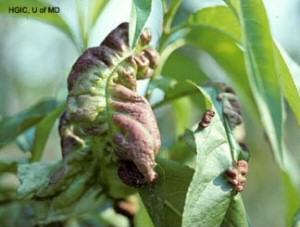Leaf Curl of Peaches
 Causal Agent
Causal Agent
The fungus, Taphrina deformans
Hosts
Peaches and nectarines
Symptoms
Infected leaves pucker, become deformed, and turn yellow or reddish-brown. Diseased leaves eventually wither and fall from the trees. Although new leaves emerge from dormant buds, their growth requirements reduce yield and may weaken the trees. Defoliation of trees in several successive seasons may result in their death. Spores of the leaf curl fungus survive the summer, fall and winter months on bud scales, on twigs and on fallen, infected leaves. During periods of moist weather in early spring, the overwintering ascospores from conidia and they are carried into the buds on a film of water. During bud and swell and opening, the newly-developing leaves become infected. Cool, wet weather slows down leaf development and provides more time for leaf infection. Infection occurs readily at 50-70F, 68F being optimum. As the leaves grow and mature, they become less susceptible to infection. Secondary infection rarely occurs and is unimportant. If the weather is dry during bud swell and bud break, leaf curl is limited, perhaps not even occurring. However, any spores present may survive and infect trees another season. The leaf curl fungus not only infects leaves, but also tender growing shoots and, more rarely, blossoms and fruits. Infected twigs become slightly swollen, may be yellowish and remain stunted. Infected blossoms and fruit usually fall early in the season. However, some infected fruit may remain in the trees. Diseased fruit will show shiny, raised, warty, discolored areas.
Control
Leaf curl is one of the relatively few serious diseases which may be easily, economically and effectively controlled. If a recommended fungicide is applied at the correct time, 95-98% control is usually obtained. A fungicide spray is most effective when applied just before swelling of the buds. Timing depends on temperature and rainfall pattern of the season in each area of the state, usually February to March. In commercial practice, an earlier application is frequently made. Ordinarily only one application is required, but if bud opening is delayed during cold weather, or frequent rainfall occurs, a second application may be required. A fall application after leaf drop may be helpful. If must be remembered that leaf curl cannot be controlled after the fungus has infected the leaves and that fungicide applications must be made before the buds begin to swell. Thorough and complete coverage of twigs, branches, and trunks is required. When leaf curl is severe, maintenance of tree vigor is very important. Fruit should be thinned, the trees should be adequately irrigated, and the trees should be fertilized with a nitrogen fertilizer during early summer. Please contact your local county extension office for current information.

